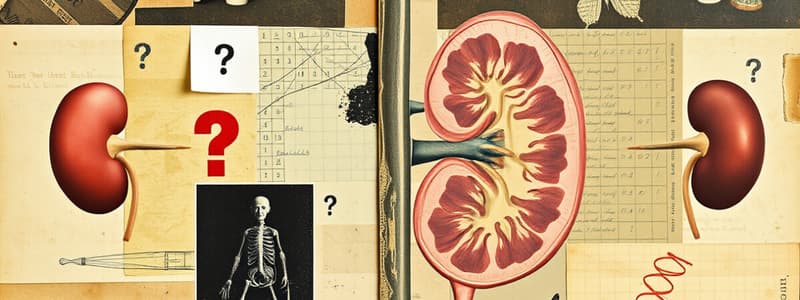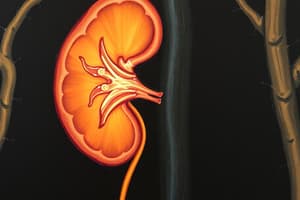Podcast
Questions and Answers
What is the primary function of ultrafiltration in the kidneys?
What is the primary function of ultrafiltration in the kidneys?
- To buffer the acid concentrate
- To remove wastes
- To push fluid through a semipermeable membrane using pressure (correct)
- To drag solutes across the membrane
Osmosis involves fluid moving from an area of high concentration to low concentration.
Osmosis involves fluid moving from an area of high concentration to low concentration.
False (B)
What is hyperkalemia and what is one of its symptoms?
What is hyperkalemia and what is one of its symptoms?
Hyperkalemia is when potassium levels are greater than 5.5 and can cause muscle weakness.
______ buffers the acid concentrate in the dialysate solution.
______ buffers the acid concentrate in the dialysate solution.
Match the following conditions with their potassium levels:
Match the following conditions with their potassium levels:
Which process describes the movement of solutes dragged across a semipermeable membrane along with fluid?
Which process describes the movement of solutes dragged across a semipermeable membrane along with fluid?
What is the most common underlying cause of chronic kidney disease (CKD)?
What is the most common underlying cause of chronic kidney disease (CKD)?
Patients with dry, itchy skin should use regular soaps and lotions for hydration.
Patients with dry, itchy skin should use regular soaps and lotions for hydration.
What is uremia?
What is uremia?
A common infectious complication in hemodialysis patients is __________ infections.
A common infectious complication in hemodialysis patients is __________ infections.
Match the following kidney conditions with their characteristics:
Match the following kidney conditions with their characteristics:
Which statement is true regarding the kidney's endocrine functions?
Which statement is true regarding the kidney's endocrine functions?
The life span of red blood cells in dialysis patients is longer than normal.
The life span of red blood cells in dialysis patients is longer than normal.
What should patients with peripheral neuropathy avoid?
What should patients with peripheral neuropathy avoid?
What percentage of normal kidney function is replaced through hemodialysis?
What percentage of normal kidney function is replaced through hemodialysis?
The inflammation of the membrane around the heart is called __________.
The inflammation of the membrane around the heart is called __________.
Flashcards are hidden until you start studying
Study Notes
Ultrafiltration and Kidney Functions
- Ultrafiltration uses pressure to push fluid through a semipermeable membrane.
- Convection drags solutes across the membrane with fluid movement.
- Diffusion involves particle movement from high to low concentration areas.
- Osmosis is fluid movement from low to high concentration areas.
- Kidneys normalize electrolytes, remove waste, and maintain fluid and acid-base balance.
Replacement of Excretory Functions
- Acid concentrate establishes concentration gradients for efficient diffusion.
- Bicarbonate buffers acid concentrate to normalize body pH in patients' blood.
- Only 15% of normal kidney function is replaced by hemodialysis.
Electrolyte Imbalances
- Hyperkalemia occurs with potassium > 5.5, presenting symptoms like muscle weakness and abnormal heart rhythms.
- Hypokalemia occurs with potassium < 3.5, with symptoms including fatigue, paralysis, and potential respiratory failure.
Endocrine Functions of Kidneys
- Kidneys secrete renin, erythropoietin, and activate vitamin D.
- Normal endocrine functions are replaced with medications.
Chronic Kidney Disease (CKD) Impact
- Uremia is the accumulation of waste due to kidney failure.
- Common causes of CKD include diabetes, hypertension, and polycystic kidney disease.
- Symptoms of fluid imbalance: hypertension, edema, shortness of breath.
Sodium Balance and Related Health Issues
- Sodium balance affects blood volume, cardiac output, and blood pressure.
- Left ventricular hypertrophy can result from prolonged fluid overload and hypertension.
Skin and Peripheral Neuropathy Care
- Dry, itchy skin should be treated with hyper-fatted soaps and lotions.
- Patients with peripheral neuropathy should avoid walking barefoot to prevent injuries.
Cardiac Complications
- Left ventricular hypertrophy increases the risk of ischemic heart disease and arrhythmias.
- Pericarditis, inflammation of the heart membrane, is treated by adjusting heparin doses and increasing dialysis.
Anemia in Dialysis Patients
- Patients often develop anemia due to shorter red blood cell lifespan (60 days compared to 120 days).
- Primary anemia cause is erythropoietin deficiency, manageable with appropriate dosing and blood line rinsing.
CKD-Mineral Bone Disorder (CKD-MBD)
- Key elements: calcium, phosphorus, parathyroid hormone (PTH), and vitamin D.
- Symptoms include soft tissue calcification, muscle weakness, and increased fracture risk.
Acute Kidney Injury (AKI) Causes
- Pre-renal causes: obstruction, volume depletion, impaired cardiac function.
- Intra-renal causes: ischemic acute tubular necrosis (ATN), sepsis, drug reactions, glomerulonephritis.
- Post-renal causes: obstruction, bladder rupture, complications from pregnancy.
Prevention and Management Strategies
- Eliminating AKI causes may restore kidney function, unlike with CKD.
- Patients with dialysis catheters require specialized care to prevent infections.
- Avoid nephrotoxic substances such as certain contrast agents and nonsteroidal anti-inflammatory drugs (NSAIDs).
Monitoring and Safety Protocols
- Patients’ weight and blood pressure indicate excess fluid for kidney filtering.
- AKI patients face increased risks of hypovolemia and hypotension.
- OSHA mandates safe working conditions; CMS focuses on patient care and safety.
Infection Control in Dialysis
- V-Tags outline regulations for infection control practices.
- Soap and water are the only acceptable hand hygiene for C. diff patients.
- Hemodialysis patients frequently experience MRSA infections and other vascular access complications.
Equipment and Dialysis Parameters
- Dialysis machine alarms must be tested before each treatment.
- Dialysate pH should be maintained between 6.9 and 7.6; conductivity values must range around 0.4.
- Bleach testing is necessary post-disinfection before equipment use.
Dialysate and Treatments
- Total proportion of dialysate used in treatments is 45X.
- Standard potassium levels in dialysate concentrates are 2.0 K+ and 3.0 K+.
- Glomeruli function similarly to the semipermeable membranes in dialyzers, crucial for waste removal such as BUN and creatinine.
Studying That Suits You
Use AI to generate personalized quizzes and flashcards to suit your learning preferences.




